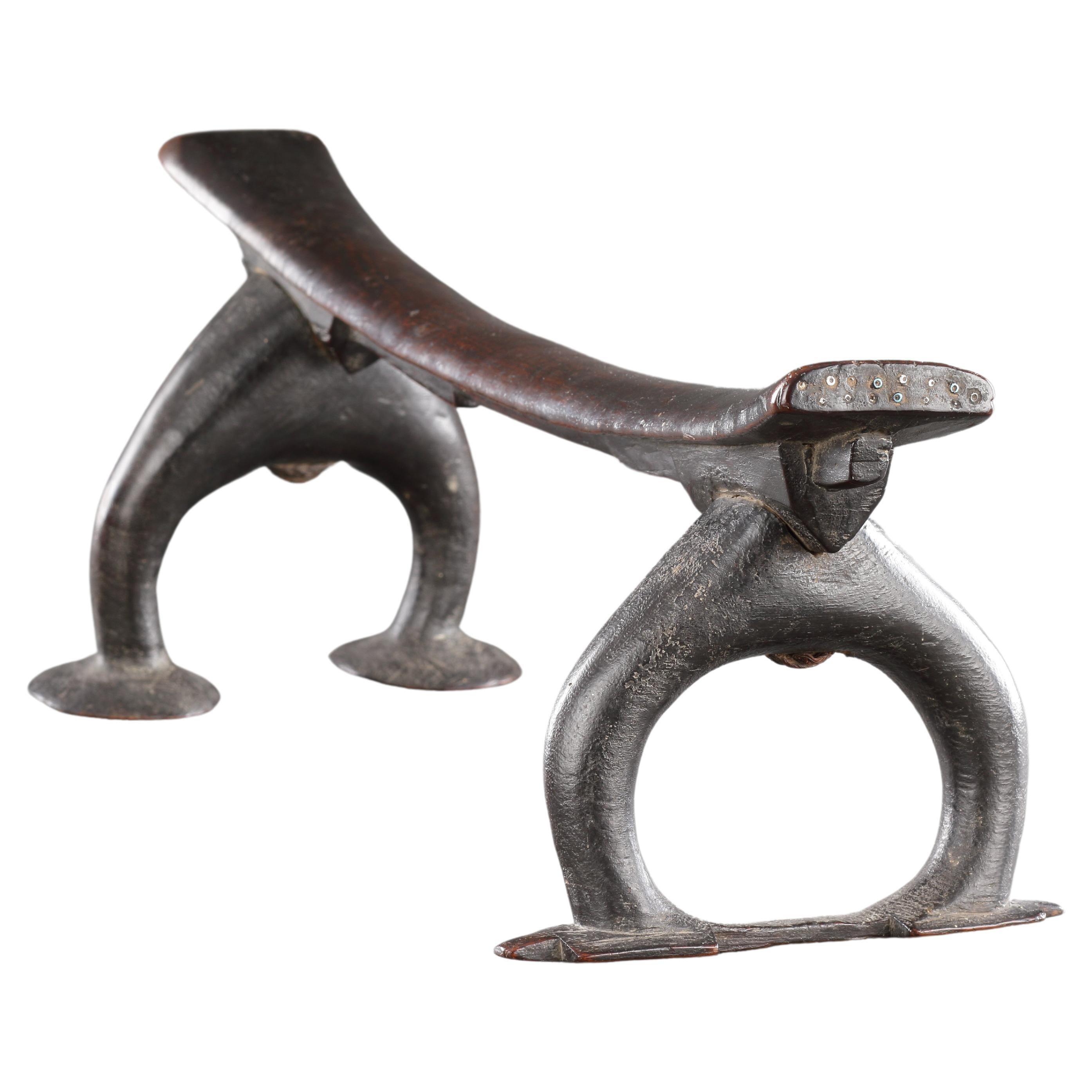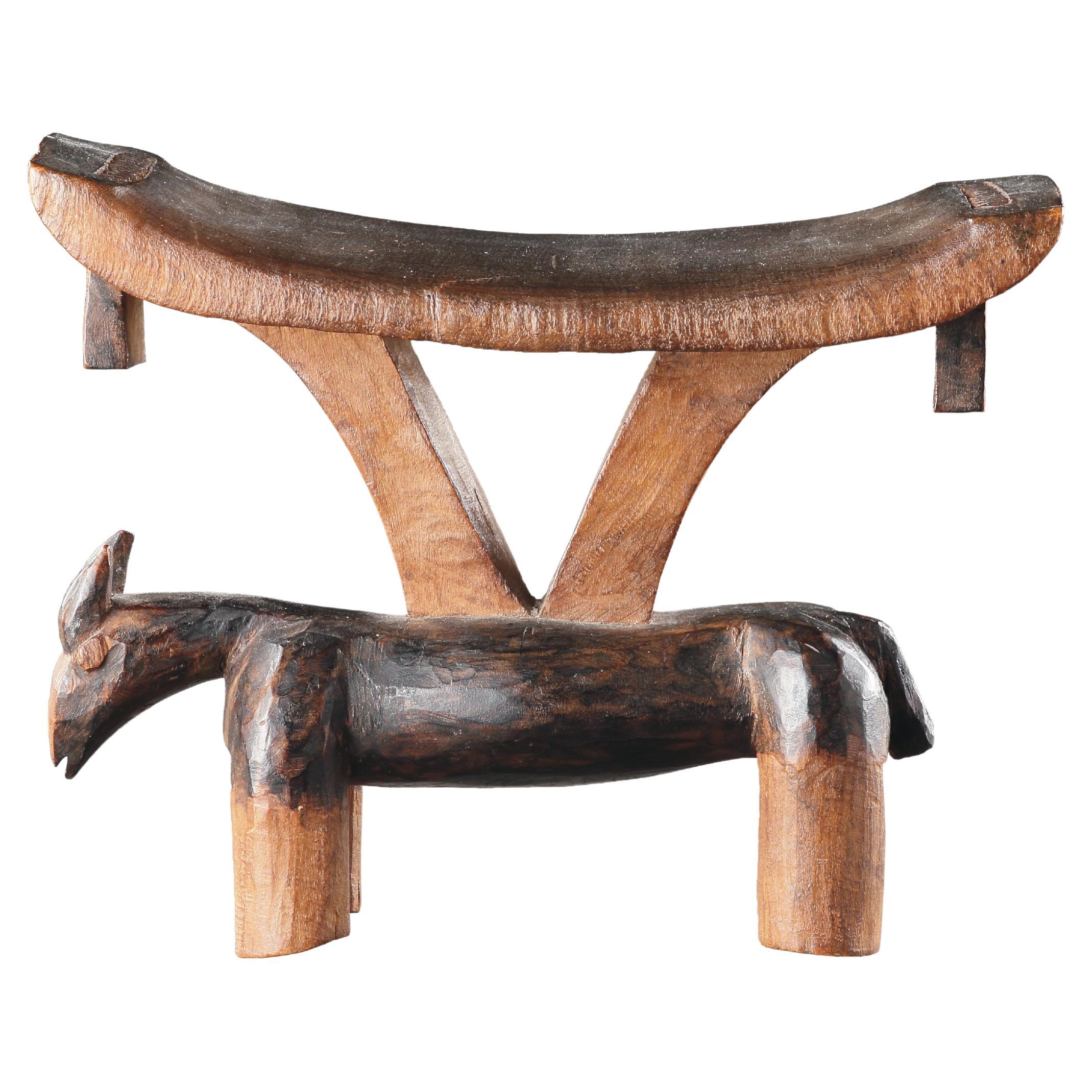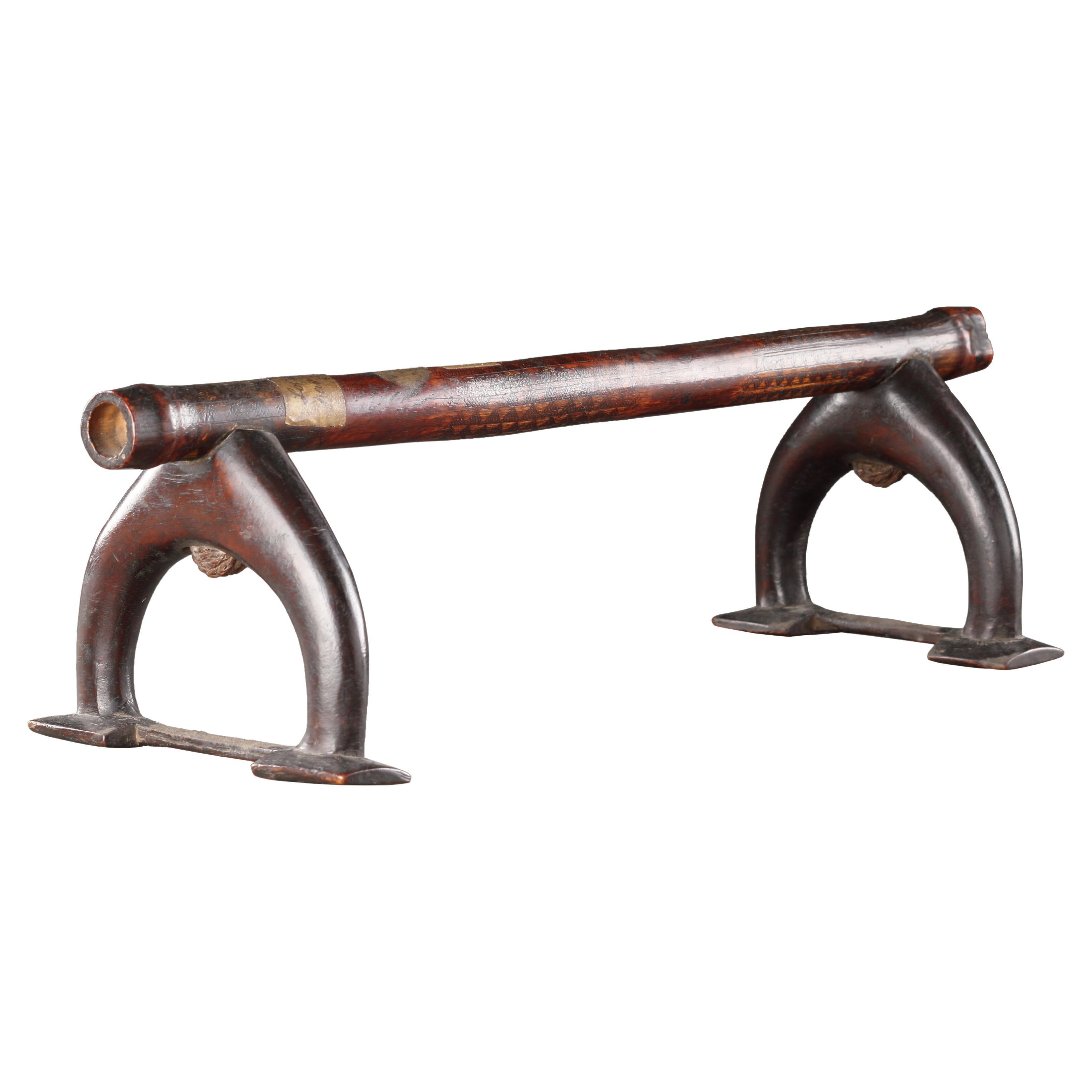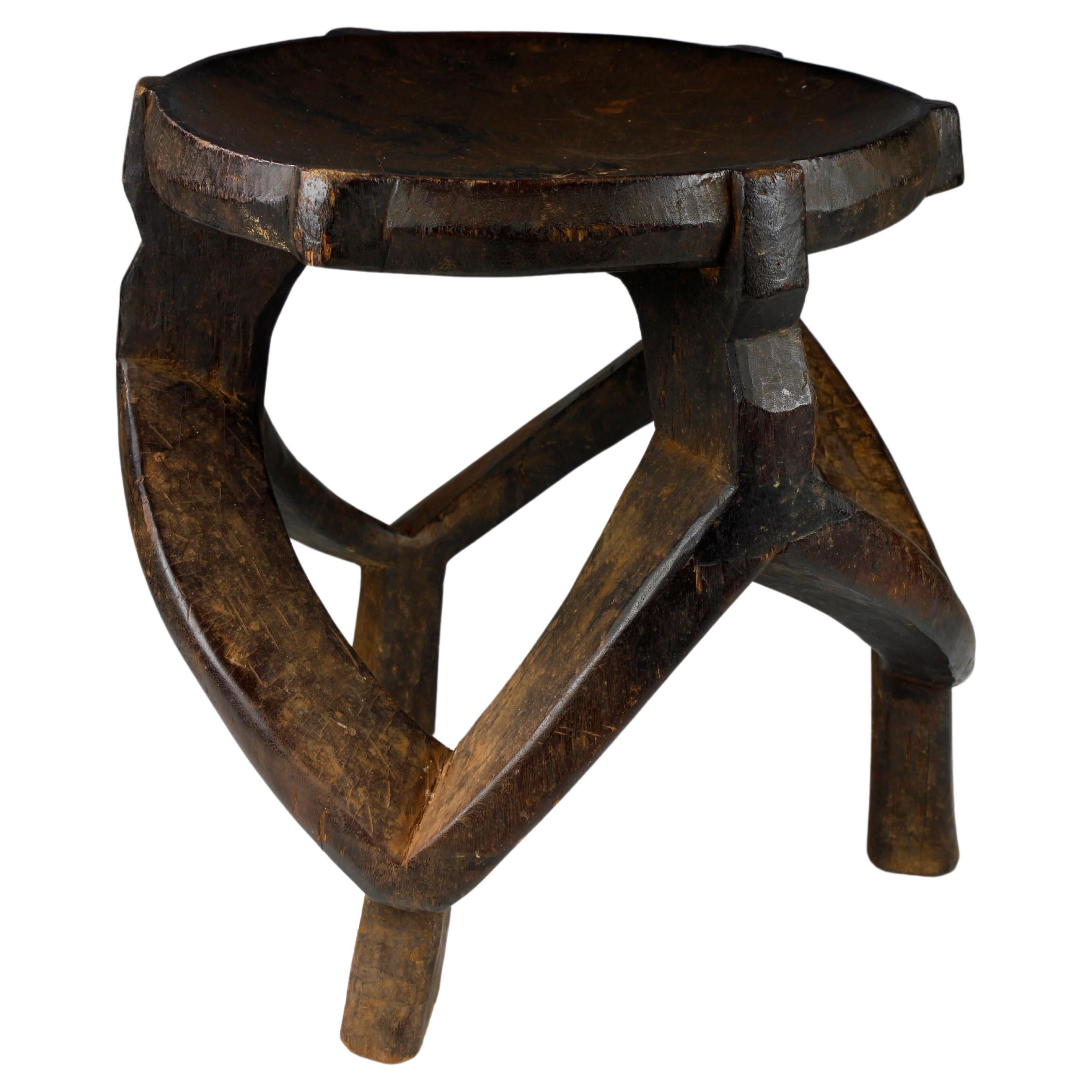Items Similar to A Rare and Finely Carved Egyptian Wooden Headrest
Want more images or videos?
Request additional images or videos from the seller
1 of 9
A Rare and Finely Carved Egyptian Wooden Headrest
About the Item
A Rare and Finely Carved Egyptian Wooden Headrest with a Carved Head to both Sides Representing the God ‘Bes’ (Protector of the Homestead) above Carved ‘Lilies’ Decorated to the Stem
Fine old aged glossy patina
An old paper label to the underside ‘80’
Two Victorian nails to the base once supporting a rectangular ‘museum’ display or description card
Egypt
Ramesside Period / 13th - 12th Century B.C
Size:
19cm high, 8cm deep, 22.5cm wide - 7½ ins high, 3¼ ins deep, 8¾ ins wide
Provenance:
by repute: Judge Herbert Blum (1900 - 1992) Baltimore Maryland USA
Herbert F. Rieser, London, during the 1960s
Acquired by Barbara Kornblatt (b. 1931) niece of Judge Blum
Sold at Harris Auction House, 1990s, Baltimore, Maryland USA
Ex Private UK collection
When they slept the ancient Egyptians rested their heads on low wooden or stone supports. The fundamental form of a flat base, straight shaft and a neckpiece carved to accommodate the head appeared as early as the First Dynasty (3100 - 2890 B.C) and continued through the Ptolemaic period. Elaborate hairstyles necessitated the use of the headrests in order to protect time consuming and expensive hairdressing. The hard pillow or platform kept the wigs and braiding from being damaged during sleep. They were also remarkably comfortable as long as one did not roll over. Similar wooden headrests are still used today in West Africa.
As a support for the most vulnerable part of the body when it was most at risk from the powers of darkness, the headrest was a potent symbol of protection and was often placed in sarcophagi next to the mummy’s head or supporting it. As important burial gifts, headrests served to assist the deceased in his or her quest for immortal life.
Elegantly proportioned ancient Egyptian wood furniture was made for the use of the elite; by modern standards the houses of the poor had very little furniture. Headrests have been found in the tombs of Kings, Queens and their officials together with low stools, chairs, bed frames, jar stands and boxes.
- Dimensions:Height: 7.5 in (19.05 cm)Width: 8.75 in (22.23 cm)Depth: 3.25 in (8.26 cm)
- Materials and Techniques:
- Place of Origin:
- Period:
- Date of Manufacture:13th - 12th Century B.C
- Condition:Wear consistent with age and use.
- Seller Location:London, GB
- Reference Number:1stDibs: LU9363237482722
About the Seller
New to 1stDibs
Joined in the past six months.
No Reviews Yet
Vetted Seller
These experienced sellers undergo a comprehensive evaluation by our team of in-house experts.
Established in 1989
1stDibs seller since 2023
- ShippingRetrieving quote...Ships From: London, United Kingdom
- Return PolicyA return for this item may be initiated within 14 days of delivery.
More From This SellerView All
- A Rare and Exceptional Carved Headrest ‘Kali Hahapo’Located in London, GBA Rare and Exceptional Carved Headrest ‘Kali Hahapo’ Excellent colour and patina Wood, sennet (coconut fibre), glass beads Tonga Late 18th / Early 19th Century SIZE: 19cm high, 5...Category
Antique Early 19th Century Tongan Tribal Art
MaterialsNatural Fiber, Glass, Wood, Coconut
- A Rare Anthropomorphic Tsonga HeadrestLocated in London, GBA Rare Anthropomorphic Tsonga Headrest An old paper label: ‘African Pillow Bt. Webster. Sep 1897. P.’ Fine colour and patina through use Wood, pigment, paper label Zimbabwe 19th...Category
Antique 19th Century Zimbabwean Tribal Art
MaterialsWood, Paper
- A Very Fine and Rare Headrest ‘Kali’ or ‘Kalimasi’ / ‘Kali Toloni’Located in London, GBA Very Fine and Rare Headrest ‘Kali’ or ‘Kalimasi’ / ‘Kali Toloni’ Bamboo, wood, coconut ‘sennet’ fibre The ‘cross-bar’ (rest) engraved with triangular design reminiscent of ‘Tapa C...Category
Antique Early 19th Century Tongan Tribal Art
MaterialsBamboo, Natural Fiber, Wood, Coconut
- A Finely Carved ‘Boni’ Neck-RestLocated in London, GBA Finely Carved ‘Boni’ Neck-Rest Superb dark colour and patination through extended use Wood Somalia 19th Century SIZE: 18.5cm high, 15.5cm wide - 7¼ ins high, 6 ins wide These hea...Category
Antique 19th Century Tribal Art
MaterialsWood
- An Unusually Large and Fine Tsonga ‘Antelope’ HeadrestLocated in London, GBAn Unusually Large and Fine Tsonga ‘Antelope’ Headrest Wood, pigment, glass beads Zimbabwe 19th Century SIZE: 20cm high, 32cm wide - 8 ins high, 12½ ins wide PROVENANCE: Ex Pri...Category
Antique 19th Century Zimbabwean Tribal Art
MaterialsGlass, Wood
- A Rare and Historically Important Artefact Recovered from HMS Adventure in 1775Located in London, GBA Rare and Historically Important Artefact Recovered from HMS Adventure in 1775 after Captain James Cook’s Second Voyage to the Pacific A ‘coconut husker’ made by a ship’s carpenter aboard HMS Adventure in the style and design of a Native Islander’s ethnographical ‘coconut husker’ An engraved and inscribed copper plaque: A memento from The Sandwich Islands Coconut Husker used aboard HMS Adventure and recovered from The Royal Dockyard Deptford 1775 Oak, iron, brass, copper, handmade iron screws Fine rich colour and patina England / Sandwich Island 18th Century SIZE: 15.5cm high, 49.5cm long, 20cm wide (max) - 6¹⁄₈ ins high, 19½ ins long, 7⁷⁄₈ ins wide (max) Provenance: Found in a Scottish attic after centuries of lying hidden in a crate Ex Private Scottish collection Captain James Cook’s second voyage aboard the Resolution and accompanied by HMS Adventure set sail in July 1772. The discovery of the southern eight islands of the Sandwich Islands group was in 1775. The given name was chosen in honour of John Montagu, 4th Earl of Sandwich, First Lord of the Admiralty. The copper plaque and inscription however should not be read as The Sandwich Islands ‘Owhyhee’ (The Hawaiian Islands) which were later discovered on January 18th, 1778, on Captain Cook’s third voyage. Rather the inscription refers to ‘South Sandwich Islands’ lying to the south east of South Georgia and only renamed later with the word ‘South’ to distinguish them from the ‘Sandwich Islands’ now known as the Hawaiian Islands. Not withstanding during Cook’s second voyage he visited Easter Island, Tahiti, Society Islands, Niue, Tonga, New Hebrides, New Caledonia, Norfolk Islands, Palmerston Island and South Georgia. The crew onboard having been exposed to various types of ‘coconut huskers’ adapted those designs into the example we now see, having been rescued from HMS Adventure in 1775. A rare example of 18th century cross...Category
Antique 16th Century American Tribal Art
MaterialsBrass, Copper, Iron
You May Also Like
- Wooden Ethiopian HeadrestLocated in Chicago, ILSo as not to muss their intricate hairstyles, tribal leaders would rest their heads on these petite wooden stands. The combination of conic base and concave rest gives these function...Category
Mid-20th Century Ethiopian Tribal Abstract Sculptures
MaterialsWood
- Finely Carved Tanzanian Chieftain's StoolLocated in London, GBThis beautifully carved title stool, from the Gogo culture in Tanzania, features a wonderful looped and adjoining structure. Dating back to the mid-twentieth century, this fine examp...Category
Mid-20th Century Tanzanian Tribal Tribal Art
MaterialsWood
- Dinka stylized animal form carved wood headrest, East AfricaLocated in Point Richmond, CADinka stylized animal form carved wood headrest, East Africa. On three "legs" with curved top. Deep patina from handling and use. 12 1/2 inches long, Created mid 20th century or e...Category
Mid-20th Century Nigerian Tribal Tribal Art
MaterialsWood
- Early Twentieth-Century Finely Carved Small ChairLocated in London, GBThis early twentieth-century small chair displays a beautiful form. Typically low to the ground, such chairs are found among the Dan and Baule cultures in the Ivory Coast. Carved fro...Category
Early 20th Century Ivorian Tribal Tribal Art
MaterialsHardwood
- Ashanti tribal headrestLocated in London, GBA good example of an African Ashanti tribal headrest. Ghana. Early to mid-twentieth century.Category
Mid-20th Century Ghanaian Tribal Tribal Art
MaterialsWood
- Zulu Tribal Carved Wood Snuff Container, South Africa Finely Carved IncisedLocated in Point Richmond, CAZulu Tribal carved wood Snuff Container, South Africa A finely carved snuff container with finely carved incised great geometric designs, a great example of the detailed work the Zu...Category
Early 20th Century South African Tribal Tribal Art
MaterialsWood
Recently Viewed
View AllMore Ways To Browse
Antique Judges Chair
Kingsize Wood Beds
Tribal Wooden Box
Victorian Wooden Bed
1960s Platform Bed
Queensize Bed Frames
Queensize Beds And Bed Frames
Long Low Stools
Modern Kingsize Beds
Queens Beds
Queensize Bed
Queensized Beds
Ceremonial Stick
Hickory Chair Factory
Historical Objectivity Seller
India Crewel
Kandem Opaline
Karen Klint





